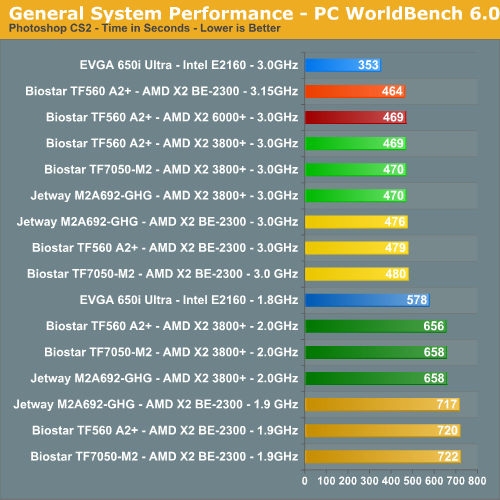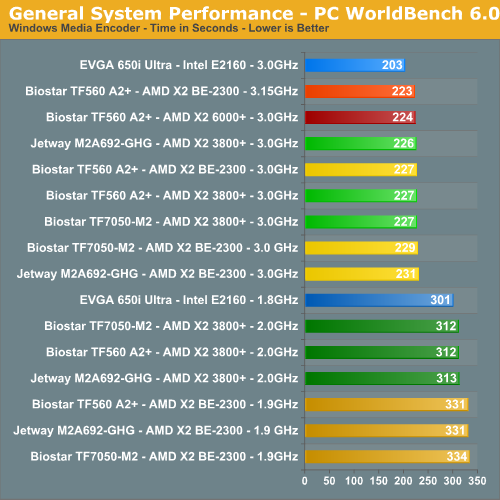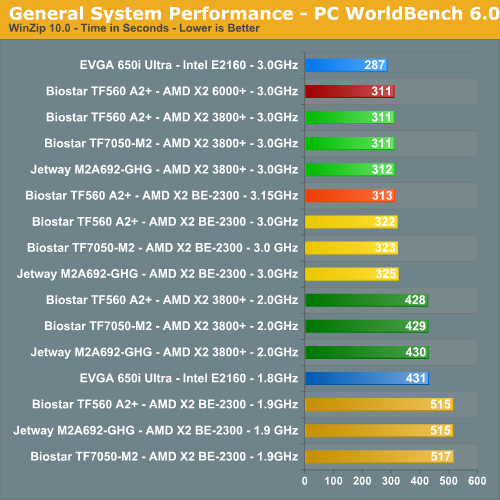Biostar TF560 A2+: Overclocking NVIDIA's new nForce 560
by Gary Key on August 2, 2007 12:15 AM EST- Posted in
- Motherboards
General System Performance
The PC WorldBench 6.0 test suite developed and provided by PCWorld is designed for determining overall system performance for the home office user. This tool provides results for ten different real world applications that range from Adobe Photoshop to AutoDesk 3ds Max. This benchmark is useful for providing comparative results across a broad array of Graphics, CPU, Hard Disk, and Memory configurations. We chose a subset of this package that represents applications more commonly used in the home environment.
Adobe Photoshop CS2

Since the introduction of the Intel Core 2 Duo architecture, Intel has enjoyed a significant lead in this particular benchmark. The E2160 is 13% faster at stock than the 3800+ and 33% faster when overclocked. Our overclocked AM2 budget processors perform roughly equal to our reference X2 6000+. The BE-2300 has a performance increase of 51% when overclocked while the X2 3800+ improves by 40% and the E2160 ends up 64% faster - almost perfectly linear performance scaling with clock speed.
Windows Media Encoder 9.0

Once again, our overclocked AM2 budget processors perform the same as our reference X2 6000+ while the E2160 leads the grouping, although the margin of victory is much smaller in this test. Like Photoshop, WME tends to favor the Core 2 architecture. The BE-2300 has a performance increase of 32% while the X2 3800+ improves by 28% when overclocked. The E2160 shows a 48% improvement when overclocked, scoring 10% faster than the next closest competitor versus only 3.6% faster at stock speeds.
WinZip 10.0

In our final benchmark that is generally CPU throughput and memory latency sensitive, we see the BE-2300 has a performance increase of 60% while the X2 3800+ improves by 38% when overclocked. The E2160 improves by 50% with overclocking. Based on CPU speed alone, our two budget AM2 processors are once again equal with our X2 6000+. There's nothing surprising there, though the fact that the increased HTT speeds of our budget processors overcame the L2 cache advantage of the 6000+ in our application tests is at least somewhat interesting. The E2160 again takes top honors among the overclocked budget CPUs, scoring 8.4% faster than the others; at stock speed it's roughly the same performance as the 3800+.
In a quick recap of the PC WorldBench results, the three AM2 boards all more or less tie when equipped with the same CPU. There are minor variations, but nothing statistically significant.
The PC WorldBench 6.0 test suite developed and provided by PCWorld is designed for determining overall system performance for the home office user. This tool provides results for ten different real world applications that range from Adobe Photoshop to AutoDesk 3ds Max. This benchmark is useful for providing comparative results across a broad array of Graphics, CPU, Hard Disk, and Memory configurations. We chose a subset of this package that represents applications more commonly used in the home environment.
Adobe Photoshop CS2

Since the introduction of the Intel Core 2 Duo architecture, Intel has enjoyed a significant lead in this particular benchmark. The E2160 is 13% faster at stock than the 3800+ and 33% faster when overclocked. Our overclocked AM2 budget processors perform roughly equal to our reference X2 6000+. The BE-2300 has a performance increase of 51% when overclocked while the X2 3800+ improves by 40% and the E2160 ends up 64% faster - almost perfectly linear performance scaling with clock speed.
Windows Media Encoder 9.0

Once again, our overclocked AM2 budget processors perform the same as our reference X2 6000+ while the E2160 leads the grouping, although the margin of victory is much smaller in this test. Like Photoshop, WME tends to favor the Core 2 architecture. The BE-2300 has a performance increase of 32% while the X2 3800+ improves by 28% when overclocked. The E2160 shows a 48% improvement when overclocked, scoring 10% faster than the next closest competitor versus only 3.6% faster at stock speeds.
WinZip 10.0

In our final benchmark that is generally CPU throughput and memory latency sensitive, we see the BE-2300 has a performance increase of 60% while the X2 3800+ improves by 38% when overclocked. The E2160 improves by 50% with overclocking. Based on CPU speed alone, our two budget AM2 processors are once again equal with our X2 6000+. There's nothing surprising there, though the fact that the increased HTT speeds of our budget processors overcame the L2 cache advantage of the 6000+ in our application tests is at least somewhat interesting. The E2160 again takes top honors among the overclocked budget CPUs, scoring 8.4% faster than the others; at stock speed it's roughly the same performance as the 3800+.
In a quick recap of the PC WorldBench results, the three AM2 boards all more or less tie when equipped with the same CPU. There are minor variations, but nothing statistically significant.










21 Comments
View All Comments
chesterman86 - Sunday, August 5, 2007 - link
any one knows which boards will work with am2+ processorsi've a evga 590sli, with a x2 4200. it will be great if i could upgrade to a phenom =D
anyway, even if i do the bios update, i'll not have ht3 right?
lopri - Saturday, August 4, 2007 - link
Thanks for the great review. The board reviewed looks solid and the coverage is, as usual, complete and clear. I always liked BioStar's boards and felt their products are not getting much spotlight among enthusiasts. The board and NV's new chipset looks solid and it's really amazing that how much computing power we get for the dollars these days.Said that, I'd like to know if Gary thinks the review samples are representative enough for retail products that one can buy, when it comes to overclocking? I haven't kept up with AMD's latest steppings and the overclocking performance of the reviewed CPUs is simply amazing. I remember the time when a 3.0GHz A64 was considered a golden.
lopri - Saturday, August 4, 2007 - link
Forgot to ask: What is the thing that going for NF560? There was a brief mention regarding GPU optimazation and PCI-E lane configuration, but overall it looks almost identical to NF550. If one were to buy a either similarly priced NF550 board or NF560 board, what would differentiate 560 from 550?CrystalBay - Thursday, August 2, 2007 - link
That is some incredible value right there .Thanks for the article G.K.!!!
Powered by AMD - Thursday, August 2, 2007 - link
Why do you use a U$S 100 Motherboard with the Intel setup and a U$S 80 one for the AMD?If we are in the cheap setup, i would like to make a comparision apples to apples.
I think if you use the U$S 85 JetWay J966GDAG-PB, the tables should be much different.
yyrkoon - Friday, August 3, 2007 - link
You try finding a decent enough Intel motherboard for under $100. Most people I know wouldnt even settle for less than a $150 + board concerning an Intel system. In-expencive/good AMD motherboards with a decent feature list have been around for a while, open your eyes, and do a product search of your own . . .crimson117 - Thursday, August 2, 2007 - link
Good point!
Also, the processors costs are not equal... (newegg prices)
Athlon 64 X2 3800+ costs $65
AMD X2 BE-2300 costs $90
Intel E2160 costs $95
AMD Athlon 64 X2 6000+ costs $170
So the AMD setup would be $50 cheaper for about equal performance.
DeepThought86 - Thursday, August 2, 2007 - link
2 PATA ports supproted but only one implemented on this board. Boo, hiss. So Biostar saves $0.50 and we're out $100 buying a new driveelpresidente2075 - Thursday, August 2, 2007 - link
All I have to say is: You've gotta move forward sometime. PATA is OK if you like slow, bulky, and outdated interfaces, but if you're into the whole "having a decent computer" thing, you're gonna have to spend the money anyway.And if you mean that you've just purchased a large PATA drive and don't want to purchase a new SATA one, I pity you and your short-sightedness. PATA is going the way of the Dodo, and SATA is the future for now.
Good luck with the new drive!
LoneWolf15 - Saturday, August 4, 2007 - link
This one made me laugh.
Not because PATA isn't an old interface. But, compare the speeds of a modern PATA drive to an SATA drive, and you'll find almost no difference. The interface isn't the bottleneck; the drive mechanics are. For that reason, an UltraATA Seagate 7200.10 and a SATA Seagate 7200.10 are within a hairsbreadth in performance.
SATA certainly cables nicer than PATA, and getting rid of the whole master/slave configuration is a great thing too. But you're buying into the hype a little too heavily. Until we can improve drive mechanics to both increase data throughput and decrease latency in more than tiny incremental steps, the interface won't matter all that much.